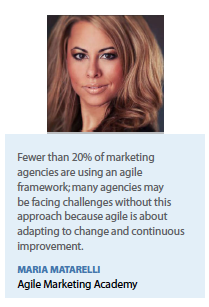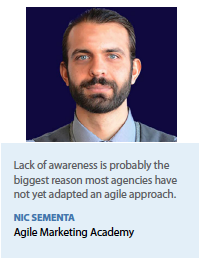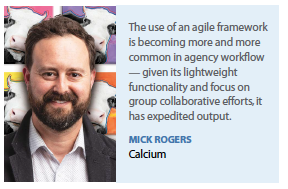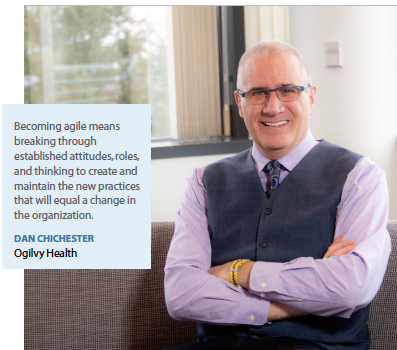Agile allows agencies to move twice as fast with more favorable outcomes.
Agency marketers are very accustomed to putting out fires, juggling tasks, as well as hats, and wading their way through daily chaos as they attempt to create successful campaigns for clients. According to our experts, there is a way to calm waters: agile marketing can help.
According to a recent article written by Deloitte research leaders, agility is both a framework and a mindset. Agility encourages organizations to embrace immediate and novel ways of thinking while helping them restructure in a way that allows their brands to join conversations and moments organically. In the chaotic marketing environment, both the mindset and the framework can prove a mighty weapon against the many iterations, pivots, and pitfalls of the marketing landscape.
While agencies have adapted to become more nimble since real-world and real-time data became available to monitor campaigns and course correct, some agencies are going a step further and  implementing a more structured working framework to extinguish the flames of chaos so endemic to their business. This environment, where events and goals happen within days, hours or even minutes, can only benefit from the streamlining, collaborating concept of agile.
implementing a more structured working framework to extinguish the flames of chaos so endemic to their business. This environment, where events and goals happen within days, hours or even minutes, can only benefit from the streamlining, collaborating concept of agile.
However, according to Maria Matarelli, co-founder of Agile Marketing Academy, fewer than 20% of marketing agencies are using an agile framework. “Agile is about adapting to change and continuous improvement, which is why many agencies may be seeing challenges without this approach," she says.
Ms. Matarelli works as an agile coach and a Certified Scrum Trainer (CST).
“The use of an agile framework is becoming more and more common in agency workflows, given its lightweight functionality and focus on group collaborative efforts; it has expedited output as compared with the traditional waterfall-style processes most of us have been accustomed to," says Mick Rogers, senior VP, creative director, art, Calcium.
Agencies have reported that an agile marketing protocol can definitely be a competitive advantage, and one that provides the ability to scale, adapt, and deliver positive outcomes for clients.
Deloitte’s leaders urge agencies to become more purposeful and hyper-focused on the human experience, which would in turn require changing how their marketing teams work. For instance, moving from reactive to proactive engagement in order to address the wants of customers. For this, they should restructure their marketing functions, leverage the power of real-time data accessed through digital platforms, and quickly gain insights to design more personalized, human experiences in an agile manner.
“Good results require commitment, and agile requires that dedication," says Dan Chichester, chief experience officer, Ogilvy Health. “Becoming agile means breaking through established attitudes, roles, and thinking to create and maintain new practices that will equal a change in the organization. That said, every organization is its own thing. Success comes from adapting agile processes to your situation."
Mr. Rogers adds that Calcium has been “dipping its toe" into the agile framework marketing ideology and has quickly realized the benefits.
“In the past, agencies looked at marketing opportunities presented as equal, yet agile frameworks now allow us to focus our energies on carefully determined high-value projects and address those cooperatively as a team and with our client partners," he says.
An agile culture is one of incremental change — rapid, frequent, consistent, and one that delivers continuous improvement. “Who wouldn’t want to be part of that?" Mr. Chichester asks. “The framework may not yet be common, but the smart money is on agencies where that interest is uncommonly high."
Today, client needs are less focused on the big campaign delivery and more oriented to what can be achieved via collaborative, adaptive relationships that bring rapid, frequent, consistent results. Every delivery is a usable and valuable increment of work: an ideal strategic framework for creative agencies to better serve their clients, Mr. Chichester adds.
Being agile typically requires marketers to shift from conventional approaches of generating marketing content to new, tech-enabled, moment-centric ones. Traditional marketing strategies were built around single campaigns, where static advertisements were developed in stages, turned on, and then turned off when the campaign ended. Brands contemplating the use of agile should  recognize the need to adapt both the framework and mindset across the organization. They need to build internal capabilities and cross-functional teams that speed up their reaction time to capitalize on societal moments, while leveraging predictive technologies to gain a share of culture and conversation rather than just a share of voice or brand impression, according to Deloitte.
recognize the need to adapt both the framework and mindset across the organization. They need to build internal capabilities and cross-functional teams that speed up their reaction time to capitalize on societal moments, while leveraging predictive technologies to gain a share of culture and conversation rather than just a share of voice or brand impression, according to Deloitte.
Challenges
However, this culture shift to agile is not always easy. “In the short-term, it can be quite an adjustment for people who have worked linearly over the years," Mr. Rogers says. “The thought process behind developing a campaign in a hierarchal fashion — using commonly accepted workflow techniques — has been ingrained into most agencies. Thus, adopting a completely different companywide methodology can be daunting."
The second co-founder of the Agile Marketing Academy, Nic Sementa, an agile marketing expert and corporate trainer, says change can be difficult for any organization, as people so often resist change. “When we look at the Satir Change Model — a model designed to help people improve the way they cope with major, unexpected change — when there is a change to the status quo, chaos often ensues," he says. “There are things that can be done to help smooth the transition." For instance, leadership support and access to training to level set the understanding of what agile is and how it can be applied are crucial.
Mr. Chichester says some of the changes required by agile can be worrisome for a traditional-minded agency. “For example, agile asks more of the client," he says. “Yesterday, a client would brief an agency and the client would see work presented a few weeks later. In tomorrow’s agile world, the same client may take on the agile role of product owner. This near-superhuman individual must uphold the overall project vision, lead review sessions, and manage feedback and requests from stakeholders. To be most effective within the agency/client dynamic, the product owner needs to be client-side."
To be successful, he suggests moving responsibilities over to clients slowly, and ramping those up as benefits become clear.
In the long-term, key stakeholders in the space are rapidly realizing the benefits to having an agile system in place that allows teams to make iterative changes in a rapid and efficient manner. The ability to efficiently deploy client feedback in real time and customize elements and build on measured impact to meet unique needs is appealing.
“The idea that embracing failure as a short-term learning experience that can then allow us to eventually produce potentially powerful projects down the road has taken some getting used to, but when viewed holistically, the value-add of being able to respond to change quickly over time, rapidly iterate, and then focus collaboratively as individuals and on interactions, one can start to see the appeal and cost benefit," Mr. Rogers says.
Getting to Agile
According to Deloitte, many marketers are diffusing the time-boxed, iterative approach across their organizations in three ways. First, they’re recognizing the need to be cross-functional and embracing a newsroom approach — breaking operational barriers and silos by bringing people closer together to produce content in the moment. Second, marketing teams are delivering content  in a more agile manner by embracing new ways of working. These include daily standups, scrums, and piloting and testing methods that can enable teams to work in shorter sprints and move away from annual and quarterly content calendars. Finally, new emerging technologies, led by AI and analytics, are supporting organizations in predicting culture changes and the direction in which the conversation is moving.
in a more agile manner by embracing new ways of working. These include daily standups, scrums, and piloting and testing methods that can enable teams to work in shorter sprints and move away from annual and quarterly content calendars. Finally, new emerging technologies, led by AI and analytics, are supporting organizations in predicting culture changes and the direction in which the conversation is moving.
While the original agile manifesto came out of software development, its principles transfer well to other approaches. For example, “Working Software over Comprehensive Documentation" is less about showmanship and theory and more about providing a clear focus on creating relevant solutions that solve actual business needs. “Customer Collaboration over Contract Negotiation" is a platform for straight communication and expectations. When there’s a clear path from what’s happening to why it’s happening to what happens next there is less nitpicking and more trust in working together.
Mr. Chichester says agencies also need to “lose the velvet curtain reveal," in order to be successful in switching to an agile framework. “There’s an undeniable psychological appeal to waiting to bring out that just right, pixel-perfect comp," he says. “But there are far more benefits to mood boards and high-level look and feel vision phases that capture and communicate enough information to get buy-in."
Mixing up the normal linear approach to a project is also helpful with agile. “A tactical approach worth exploring with a project such as a website is to avoid the expected homepage as the starting place," Mr. Chichester says. “We suggest working from the inside out to establish functionality."
Mr. Chichester also suggests marketers need to limit an endless run of work in progress because it’s important to get to a minimal viable product as quickly as possible. “Outcomes that matter come from finished work, so it’s important to focus on the task at hand and deliver high-quality work," he says. “We begin by defining the simplest features, starting with what is necessary and leaving the enhancements to the end — stop starting and start finishing."
The benefits include crafting more meaningful messages at the right time, right place, and at the right moment.
“With agile marketing and big data insights, marketers can push a clearer message to the marketplace that will resonate more with the intended audience," Ms. Matarelli says.
According to a survey by AgileSherpas, agencies that are dragging their heels on going agile are doing so because they believe how they currently work is producing good enough work, and they may also not understand the mechanics of the framework. The survey also discovered many agencies are using hybrid frameworks with 54% of agile respondents saying this is how they approach their process. This is a big jump from 2018, when only 44% reported the use of hybrid frameworks.
“Lack of awareness is probably the biggest reason most agencies have not yet adapted an agile approach," Mr. Sementa says. “It’s also easier to sell transactional marketing and not take accountability for the process.
Traditionally speaking, the model of sell and not worry about the result is what many companies do." However, he says, marketing agencies that embrace agile marketing get a better view of their ideal customers. Instead of being transactionally focused, they are focused on finding the right clients for which to provide maximum value and create results.
Taming the Interruption Madness
Now back to those marketers who are putting out fires, juggling tasks, and spending their day amidst chaos. Some reports state that marketers spend less than 40% of their work hours doing their primary responsibilities. The rest of the time is spent in meetings, responding to emails, doing administrative tasks, and putting out fires. An agile framework can help manage even an interruption-driven business such as marketing.
“Agile — when done correctly — allows for marketers and developers to work with fewer interruptions," Mr. Rogers says. “Through learned experience and practices, teams are several steps ahead of the type of traditionally accepted processes that necessitate a break in workflow." Mobility via cooperation and forward-thinking “sprints" — as opposed to one, long siloed workstream — allow for much more flexibility, he says. Brief daily stand-up meetings, organically tracking progress via a big board or specialized software, and shared equal ownership of the task at hand goes a long way to making interruptions a thing of the past.
 Mr. Chichester encourages fellow marketers to embrace agile. Instead of interruptions that lead to head-splitting and head-spinning conversations, an agile framework allows these engagements to be managed more effectively because change is expected to happen from the beginning.
Mr. Chichester encourages fellow marketers to embrace agile. Instead of interruptions that lead to head-splitting and head-spinning conversations, an agile framework allows these engagements to be managed more effectively because change is expected to happen from the beginning.
“An agile mindset is one of hyper-adaptability," he says. “Change happens. Things evolve. Every creative effort is ready for constant adaptation."
In an agile marketing framework there is a built-in gatekeeper for managing interruptions when using Scrum. It is the ScrumMaster’s role to protect the team from distractions, Ms. Matarelli says. A ScrumMaster is not typically a manager or team lead, but an influential leader and coach who does not exert direct command and control, but rather is responsible for ensuring the team lives agile values and principles and follows the processes and practices that the team agreed they would use.
In other words, agile marketing paves the way for hectic marketers to achieve more within a short period of time more quickly and accurately, while bringing forward a deliverable that resonates and succeeds with clients.(PV)
~~~~~~~~~~~~~~~~~~~~~~~~~
Putting Agile into Action
For the Organization:
Take a newsroom-style approach to data collection that informs your agile campaign.
See real-time conversations and events as an opportunity to engage with your customer base around your brand purpose, point of view, and personality.
Leverage AI-driven platforms such as Heat AI to drive near real-time customer insights that can inform more tailored, agile content at the speed of culture and conversation.
Structure your content workflow so that content stakeholders can review and approve content in tight windows of time.
Apply a theory of constraints approach to identify where the weakest links in the organization might be. Find the bottlenecks and map the interdependent activities required to make it successful.
For the CMO:
Use newfound data and analytics as evidence to show ROI in agile approaches.
Collaborate to break down silos by evangelizing for putting the customer at the center of organizational decision-making.
Let marketing be the agile champion for the organization. Use an agile approach to build your marketing function, clearly communicate success, and bring team members along by incorporating their feedback throughout the process.
For others in the C-Suite:
CEO: Empower each function to collaborate and adopt agile processes to know consumers’ needs and wants from the outside-in. Help remove organizational icebergs; start small and gain buy-in team by team; consider how roles may need to adapt and change based on what works.
CFO: Support necessary financial investments in systems and talent to enable agile processes to take hold and evolve.
CIO: As the owner of data, collaborate closely with the CMO to leverage technology and AI to fuel creative and marketing.
CHRO: Consider what types of new thinking and mindsets are needed in the workforce to become more agile, invest in reskilling and training.
~~~~~~~~~~~~~~~~~~~~~~~~~
Agile in Marketing Research
InCrowd annually surveys life-sciences market researchers to better understand who they are, how they work, and what changes and challenges are impacting the industry. As “agile" has taken off in multiple pharma operations and vendor-services, the lesson of what agile has meant for market research — brevity, speed, iterative learning, and tech-enabled prompts when their time is requested — can be a harbinger for other functions.
InCrowd developed an agile primary market research platform for the life sciences that debuted in 2010. Agile, to the market research industry, means there is a continuum of offerings from do-it-yourself platforms, to on-demand or real-time offerings, to do it in partnership representing numerous technologies plus services. The variety of options puts the pharma in the driver’s seat, with access to much of the process (interfaces, real-time views of ongoing activities and the ability to modify them immediately if desired) as a way to speed time to insights.
Data from InCrowd’s annual State of the Life Science Market Insights report in 2019 suggests the shorter, more iterative approach of agile appears to have taken hold. InCrowd found a dramatic increase during 2019 in the number of projects involving shorter surveys (30% overall increase compared with 2018) as compared with longer surveys (22% decrease). Also, when asked about specific areas of market insights investments, the data showed that several long-term, complex areas such as tracking surveys posted dramatic declines (in 2018, 47% did traditional tracking studies, vs. only 17% in 2019). The 2019 State of the Life Sciences Market Insights report reflects data from n=196 pharma and biotech market insights professionals, agencies, and consultants sourced in March 2019.
In addition, separate InCrowd data on the survey taking preferences of healthcare professionals (HCPs) sourced in July 2019 shows nearly two-thirds of physicians (64%) preferred surveys that are short and fast, while 30% of physician also prefer those for which they can get alerted via text message to complete. Non-physician healthcare professionals found these to be important considerations too, as reported by 42% and 26%, respectively. InCrowd’s internal observations regarding survey fatigue also support the data reflecting a desire by HCPs for short and fast surveys. InCrowd’s data show survey fatigue typically starts to occur within five minutes of survey taking but becomes quite pronounced after 15 minutes.
InCrowd’s HCP survey preference data was sourced on July 31, 2019, and included 506 HCPs among them 73% physicians from a variety of specialties and 27% non-physicians from various healthcare roles, including RNs, pharmacy staff, nurse practitioners, and dentists to name a few.


















